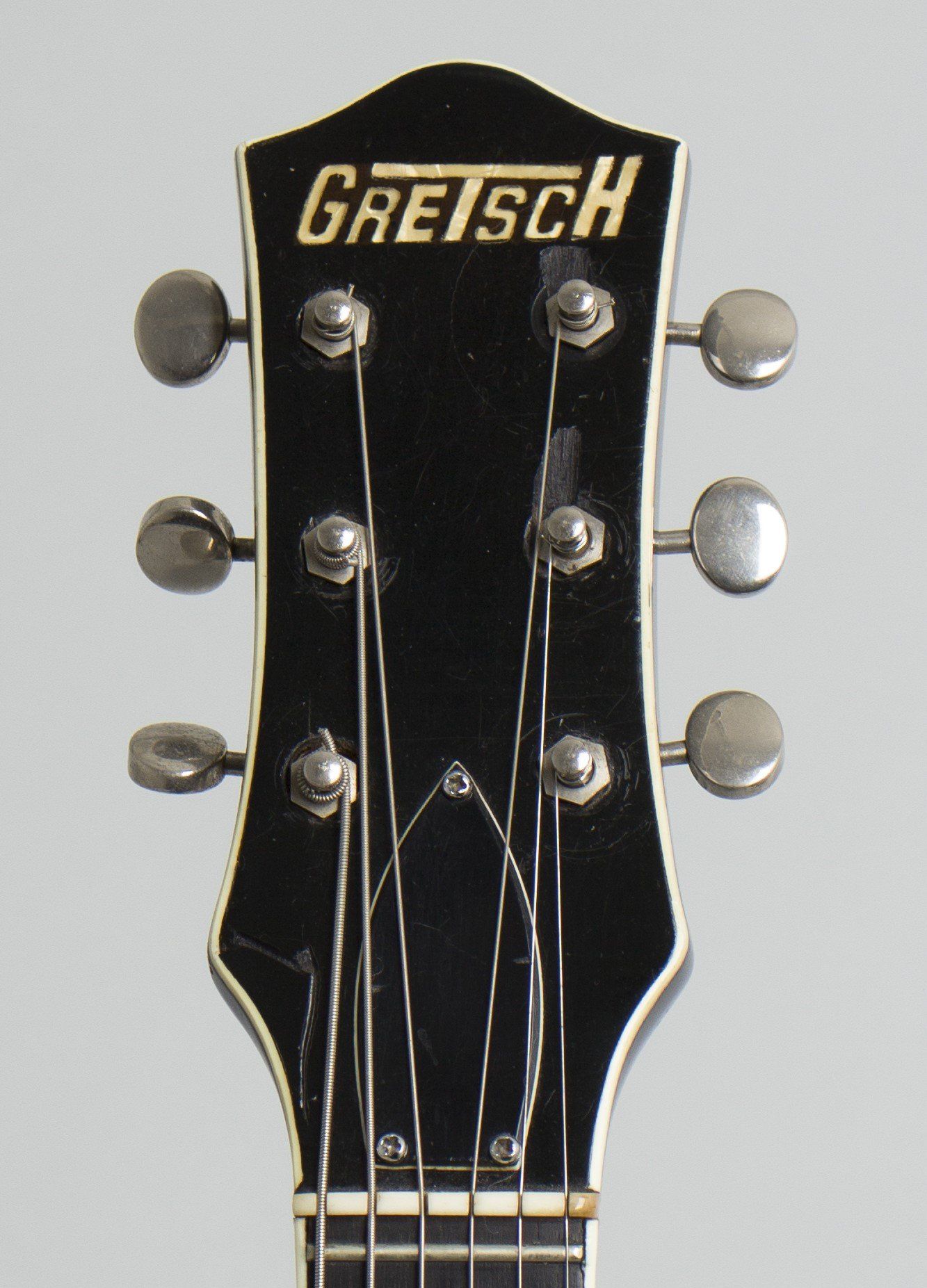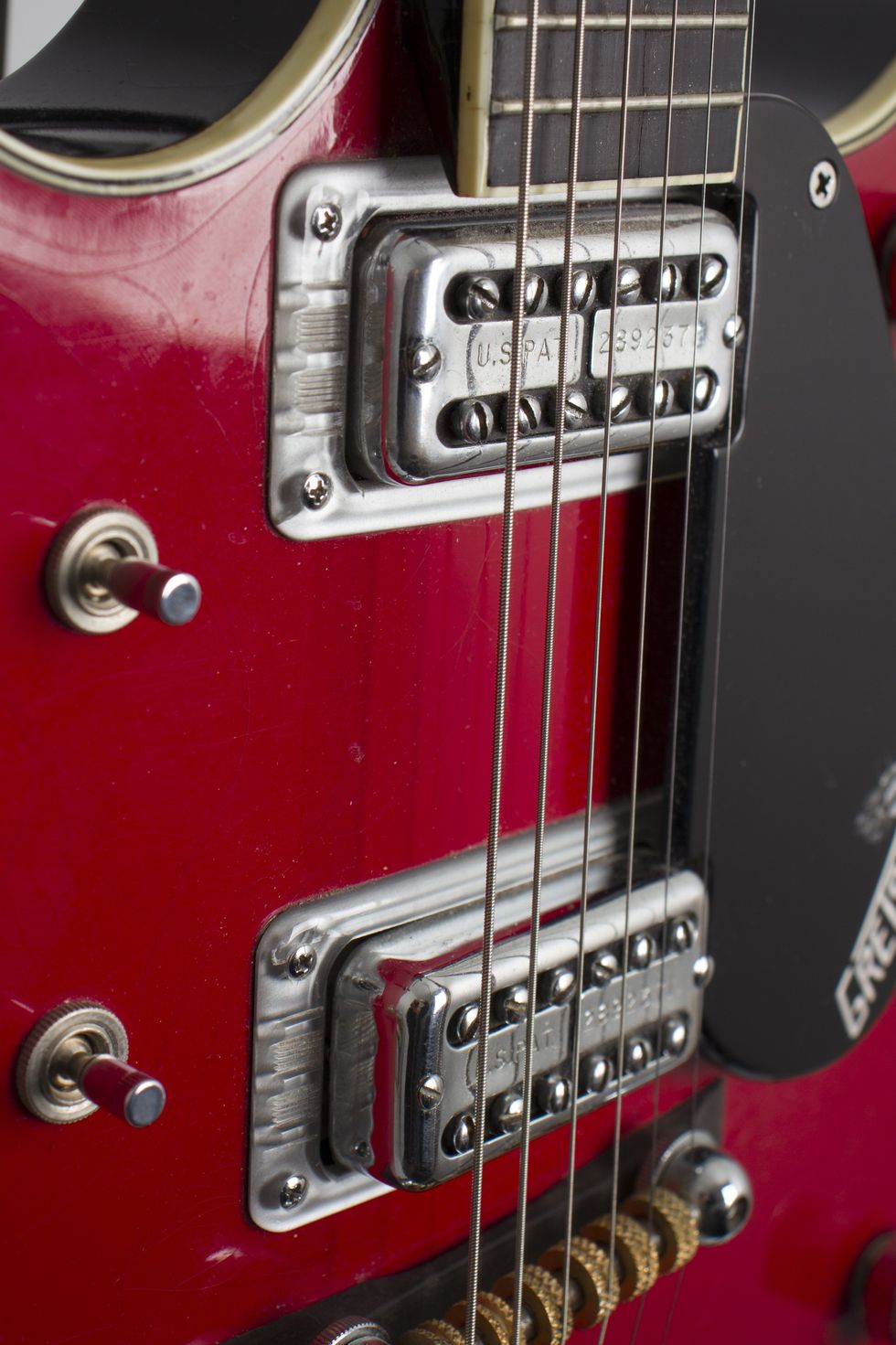An old catchphrase among vintage dealers used to run: “All Gretsches are transition models.” While their near-constant evolution was considered confusing, today their development history is better understood. This guitar however is a true transition model, built just as the Jet line was undergoing major changes in late 1961.
It also has a personal connection. A guitarist in the band I toured with in the 1980s played a Jet Firebird from this batch extensively, but later sold it. At a decades-on reunion, it was sorely missed, leading me to obtain this one to provide the same “Great Gretsch Sound,” as the company’s ads trumpeted, and style.
Gretsch’s so-called “Jet Stream” models have been one of the company’s enduring creations. Spurred by Gibson’s 1952 Les Paul, Gretsch replied with a guitar of similar size and layout, but different construction. The single-cutaway Jets appeared in late 1953. Designated as solidbodies in the catalog, they were actually semi-solid, built on a mahogany body hollowed out from above and capped with an arched plywood top. This reduced weight and gave them a different sound and feel.
“Designated as solidbodies in the catalog, they were actually semi-solid, built on a mahogany body hollowed out from above and capped with an arched plywood top.”
By 1955, Gretsch fielded a line of Jets: the black-topped Duo Jet and Western-themed Round-Up were followed by the sparkle-top Silver Jet, the red-over-black Jet Firebird and Western orange 6121 Chet Atkins solidbody. Several sold well through the ’50s, but by the turn of the decade, sales seemed to slump, as with the Les Pauls that inspired them. In 1960–’61, Gibson redesigned the Les Paul into a slim-sculpted double-cutaway. In late ’61, Gretsch restyled the Jet body into a symmetrical double-cutaway, retaining the semi-solid construction while persisting in calling them solidbodies. The new catalog announced: “Out of this world…. Find yourself soaring through musical space and time … the epitome of solidbody construction.” The revised Jet Firebird listed at $325, soon raised to $350. The actual transition occurs in a batch bearing serial numbers in the 420XX series. At the time, Gretsch numbering usually allotted 100 pre-numbered labels to a production-year model, with all Jets lumped into one batch. The label is inside the control cavity; the serial number is also hand-etched onto the back plastic cavity cover.
Jets from 1961 retain the main features of their late-1950s predecessors: twin Filter’Tron humbucking pickups, master volume on the lower cutaway, individual pickup volumes on the lower quarter with the pickup selector and tone switch (aka “mud” switch) on the upper, bass side. The Jet’s evolution happened rapidly, moving through three stages over this one batch. The first 30 to 40 420XX examples are still single-cutaways. By 42043, the double-cut body appears, showing a notable eccentricity: the pickup selection and tone switches arrayed across the upper body in a straight line above the pickups, to the rear of the prior position. Unfortunately, this meant players could easily hit them while picking, inadvertently changing tones in mid song!

Note the chips in the headstock wood—signs of an earlier alteration of the tuning pegs, now restored to vintage spec.
Photo by George Aslaender
Shortly after this Jet Firebird bearing the number 42057 was made, the switch array was moved forward to the upper horn, mounted at an angle. This change appears by 42064, suggesting only around 20 to 30 of these first-style double-cuts exist. Known examples are mostly Duo Jets, with a few Jet Firebirds and a couple of rare Sparkle Jets. These also lack the 1961–’62 standby switch fitted on the lower bout. All came stock with a solid G-logo tailpiece, although Bigsby vibratos were often added. The next Jet batch introduced the top-mounted Burns of London vibrato unit as a stock fitting and an upgrade to gold hardware. While the double-cut body gave the Jets a new, modern look, it apparently did not improve sales. The balance suffered from the upper strap button moving back several inches, but otherwise they felt and sounded pretty much like their predecessors. This model is most associated with AC/DC’s Malcom Young, who powered the band with one right from the beginning, with that particular guitar heavily altered along the way.

The company’s Filter’Tron pickups have always had their own distinctive bark.
Photo by George Aslaender
This 1961 Jet Firebird survives in more original condition. The bridge and tuners previously went missing but have been restored to original. A driver’s license number is etched on the back of the headstock, and chips on the peghead face remain from the tuner alteration. A strap button was added to the heel, giving a better balance point. The playability is excellent and the Filter’Trons offer the classic ring and crunch, accentuated by the chambered body. The neck is slim and round-backed, with a bound-ebony fretboard inlaid in the company “neoclassic” pattern, retaining the original frets. Not being a heavy-handed strummer, the eccentric switch location has never bothered me. While in the early 1960s these pseudo-solidbodies seemed to fade from popularity, for me, this early example of Gretsch “jetting” its way into the 1960s remains a solid favorite.
From Your Site Articles
Related Articles Around the Web









